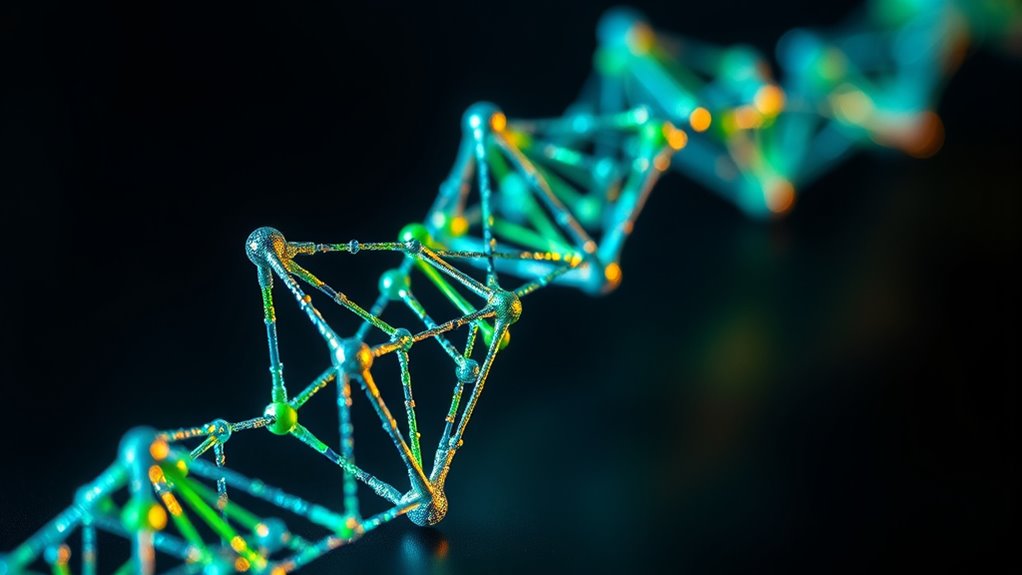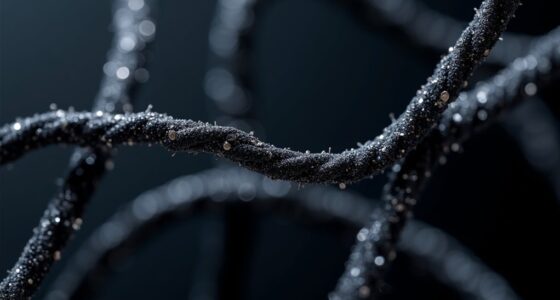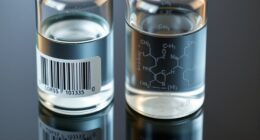DNA origami lets you build detailed nanostructures by folding a long DNA strand into specific shapes using short staple strands. This technique uses the natural base pairing of DNA to guide the creation of precise 2D and 3D structures. Advances in design tools and chemistry enable complex, functional nanodevices for medicine, electronics, and biology. Exploring more will reveal how these tiny creations are transforming science and innovation at the molecular level.
Key Takeaways
- DNA origami uses a long scaffold strand folded into precise nanostructures guided by hundreds of custom-designed staple strands.
- The process relies on Watson-Crick base pairing to program DNA sequences into specific shapes at the nanoscale.
- Computational tools translate target designs into nucleotide sequences, enabling accurate self-assembly of complex 2D and 3D structures.
- Chemical modifications allow functionalization with nanoparticles, dyes, or proteins for diverse applications like biosensing and drug delivery.
- DNA origami’s programmability and compatibility with nanomaterials enable construction of dynamic, reconfigurable nanodevices and molecular machines.
What Is DNA Origami and How Does It Work?
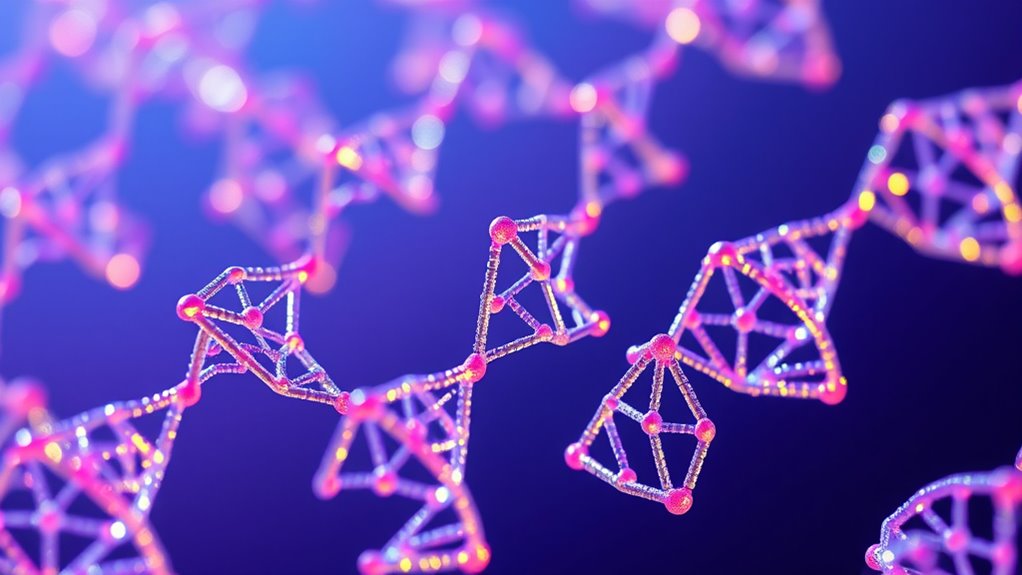
DNA origami is a technique that folds a single-stranded DNA molecule into precise nanoscale shapes, much like paper origami. You start with a long DNA scaffold, usually from a virus, and use hundreds of short staple strands designed to bind at specific sites. These staples hybridize with the scaffold through Watson-Crick base pairing, guiding it into the desired shape.
The process happens spontaneously under controlled conditions, relying on DNA’s natural affinity for complementary sequences. By carefully designing the staple sequences, you can create various two- and three-dimensional structures, from simple shapes to complex nanocubes.
This self-assembly method allows for high precision and opens new possibilities for building intricate nanostructures without cutting or gluing.
The Design Process Behind DNA Nanostructures
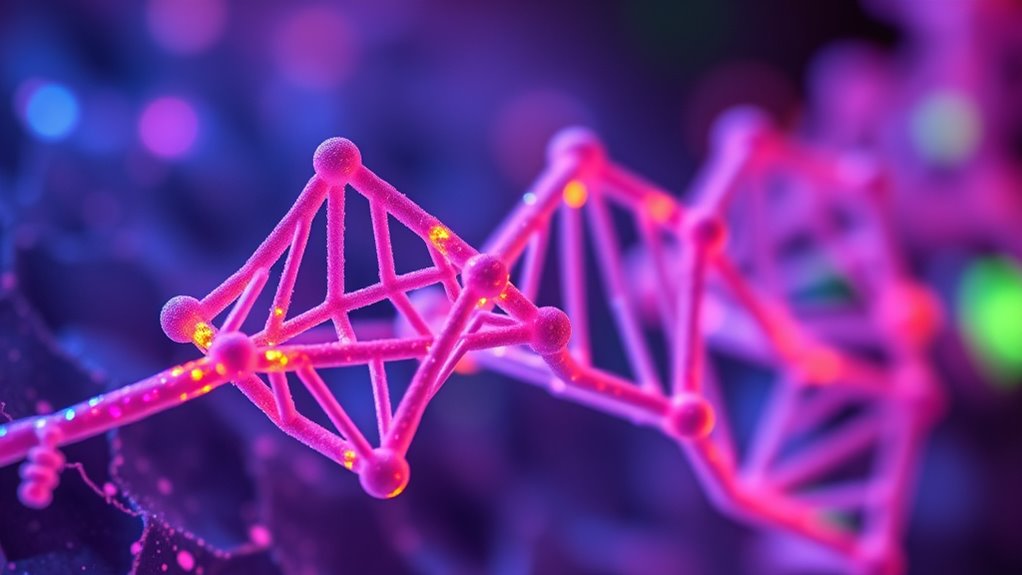
The design process behind DNA nanostructures starts with envisioning the desired shape or function, which guides the entire development. You begin by conceptualizing the target structure and creating a detailed layout that considers spatial and chemical constraints. Next, you determine the sequences for staple strands to stabilize the structure, often using computational tools to evaluate and refine your design. This iterative process guarantees the structure’s stability and accuracy. Once the design is finalized, you synthesize scaffold DNA and prepare staple strands, ensuring their purity and proper concentration. These components are pooled and subjected to self-assembly, where controlled annealing and temperature regulation guide the nanostructure into its intended shape. Throughout, techniques like gel electrophoresis verify successful folding and quality. Incorporating security measures in the process can help prevent errors and ensure the integrity of the assembled nanostructure. Additionally, understanding DNA hybridization principles is crucial for optimizing assembly efficiency and stability. Exploring energetic alignment principles can further improve the precision of nanostructure formation, ensuring highly accurate results.
Fundamental Properties of DNA Enabling Origami
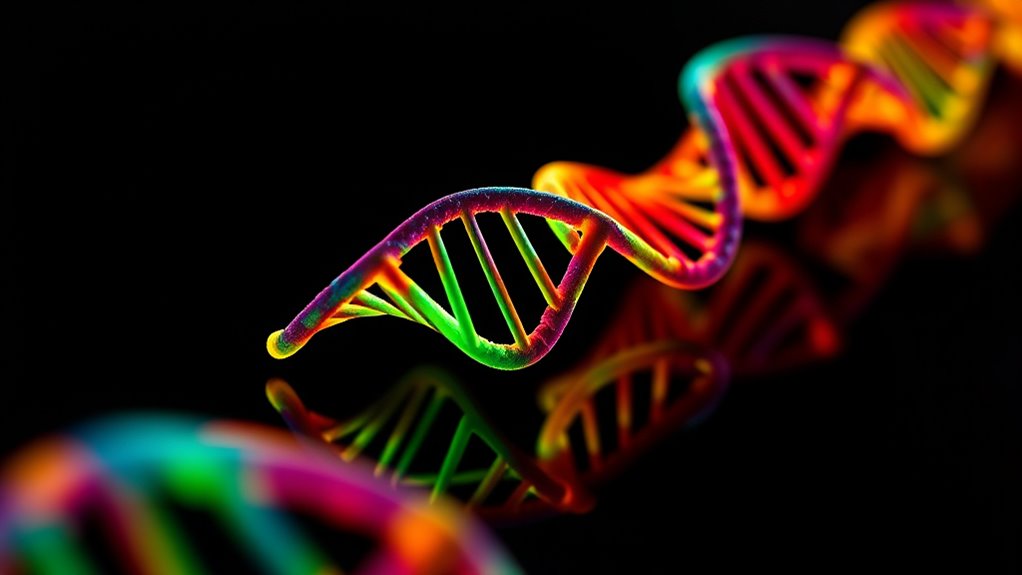
Fundamental properties of DNA are what make it an ideal material for nanoscale origami. Its ability for precise base pairing through Watson-Crick interactions allows you to program self-assembly into complex shapes. The double helix provides inherent structural stability, which you can manipulate to create durable nanostructures. Moreover, advancements in DNA nanotechnology are driven by ongoing research into automation in business and related fields, enabling more efficient design processes. DNA’s mechanical properties—elasticity, pliability, and stability—enable it to bend, stretch, and withstand mechanical forces without breaking. Its innate capacity to self-assemble from scaffold and staple strands simplifies fabrication, allowing you to build both 2D and 3D structures at the nanoscale. Additionally, DNA’s chemical stability and biocompatibility ensure your designs can endure varied environments and be used in biomedical contexts. Resources and tools, such as specialized software and laboratory techniques, further facilitate the precise construction of complex nanostructures. The development of advanced synthesis methods continues to expand the potential applications of DNA origami in fields like medicine and materials science. These fundamental qualities make DNA a versatile, reliable material for constructing intricate nanostructures with precision.
Practical Uses and Applications of DNA Origami

Have you ever wondered how DNA origami is transforming medicine and technology? This technique enables targeted drug delivery by designing structures that transport medicines directly to diseased cells, increasing effectiveness while reducing side effects. It’s also used to develop highly sensitive biosensors that detect specific biomarkers, improving diagnostics. Creativity in scientific innovation plays a crucial role in developing these advanced nanostructures, as it fosters novel approaches and problem-solving strategies.
In structural biology, DNA origami helps create precise molecular models, deepening our understanding of biological processes. Additionally, it serves as a vehicle for delivering genetic material, such as synthetic genes, into cells. The programmable nature of DNA origami allows for customization and adaptability in various applications, making it a versatile tool in nanotechnology. Understanding tensile strength and other physical properties of DNA structures enhances their stability and functionality in practical uses.
Beyond medicine, DNA origami acts as a nanoscale scaffold for assembling electronic circuits, protein crystals, and other nanomaterials. Its programmable nature allows for scalable, cost-effective manufacturing, opening doors to innovative applications across industries and paving the way for future breakthroughs in nanotechnology.
Overcoming Challenges in Building Nanoscale Shapes
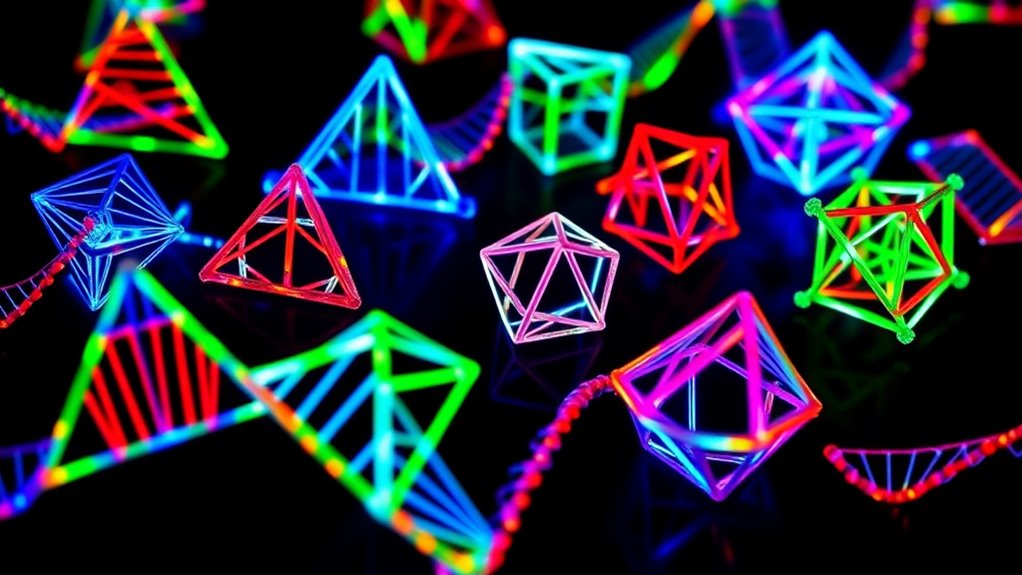
Building complex nanoscale shapes with DNA origami presents significant hurdles, primarily due to scaffold length limitations, mechanical fragility, and folding complexity. Since most designs rely on the 7 kb M13 genome, creating larger or more intricate structures becomes challenging. To address this, you can use super-tiles—smaller DNA units assembled into larger forms—or explore alternative scaffolds that offer longer, more stable strands. Hierarchical assembly allows you to piece together smaller structures efficiently. To reduce topological knots, parallel crossovers are useful, especially in single-stranded origami. Building 3D shapes requires innovative folding strategies, but maintaining stability and rigidity remains tough. Advanced modeling helps predict folding pathways, enabling you to optimize designs and improve assembly success. Incorporating machine learning techniques can further enhance modeling accuracy and predictability, streamlining the design process. These strategies collectively help overcome current limitations in nanoscale shape construction.
The Future of DNA Origami in Science and Medicine
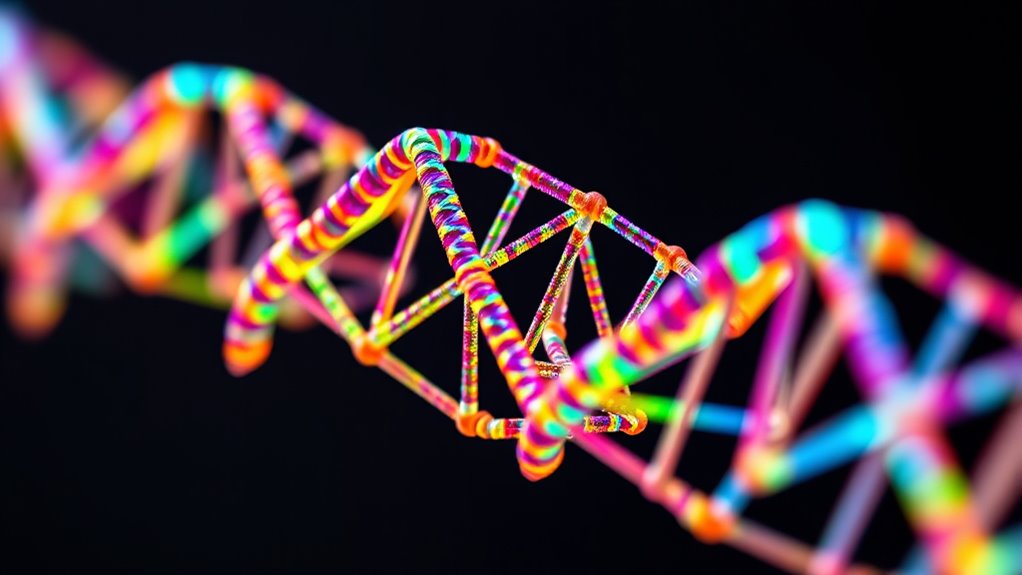
The future of DNA origami in science and medicine is poised for transformative breakthroughs as researchers develop increasingly sophisticated applications. You’ll see advanced drug delivery systems that leverage its tiny size, programmability, and ability to carry multiple molecules, enabling targeted therapies for cancer, infections, and genetic disorders.
Strengthening techniques like triplex-directed photo-cross-linking will improve stability in biological environments, making in vivo applications more viable. Diagnostic tools will become more sensitive, using DNA origami’s biosensing capabilities to detect biomarkers at ultra-low concentrations, speeding up disease detection.
Additionally, DNA origami’s role in data storage and nanoelectronics will grow, offering sustainable, high-density solutions. Its potential in photonics and quantum technologies promises innovations in light manipulation and information processing, pushing the boundaries of what nanotech can achieve.
Tools and Techniques for Creating Complex Structures
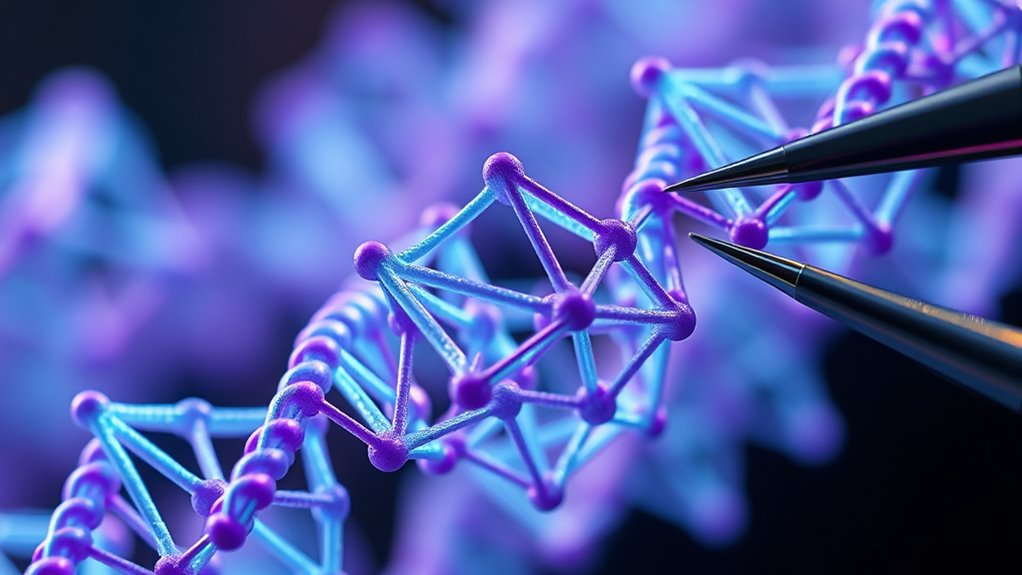
Creating complex DNA origami structures relies on a combination of specialized design tools, precise assembly methods, and chemical modifications. You start with a long ssDNA scaffold, usually from bacteriophage M13, and design about 200 short staple strands with unique sequences to fold it into the desired shape.
Design software translates your target shape into specific nucleotide sequences, simulating folding pathways and stability.
During assembly, you mix scaffold and staples in an aqueous buffer, then anneal them through controlled temperature protocols, ensuring efficient hybridization.
Chemical modifications of staple strands allow attachment of nanoparticles, dyes, or proteins, enabling functionalization at nanoscale precision.
These techniques result in high-yield, well-defined structures, providing a versatile platform for various nanotechnological applications.
The Impact of DNA Origami on Nanotechnology and Synthetic Biology

DNA origami has revolutionized nanotechnology and synthetic biology by providing a versatile platform for designing and assembling nanoscale structures with exceptional precision. You can now create both simple two-dimensional and intricate three-dimensional forms tailored for specific applications like biosensing and drug delivery.
By using voxels as building blocks, you gain reconfigurable nanostructures that serve diverse tasks. The strict Watson-Crick base pairing guarantees nanoscale accuracy in self-assembly, enabling the integration of DNA structures with other nanomaterials, such as carbon nanotubes, to develop functional devices.
In synthetic biology, DNA origami offers high programmability, allowing the creation of nanomachines for transport, sensing, and computing within biological environments. Its biocompatibility and ability to be customized open new avenues for personalized medicine and responsive systems.
Frequently Asked Questions
How Long Does It Typically Take to Fold a DNA Origami Structure?
You’re probably wondering how long it takes to fold a DNA origami structure. Typically, it takes around 35 to 40 minutes under constant-temperature conditions.
This process starts with nucleation and proceeds through multiple steps until the full structure forms.
Folding time can vary depending on the complexity of your design and the number of staple strands involved.
Monitoring real-time folding assays helps optimize and predict your assembly timeline.
What Are the Main Limitations of Current DNA Origami Techniques?
You face a mountain of challenges with current DNA origami techniques. The reliance on a single scaffold like M13 makes designing diverse shapes a nightmare.
While synthesis costs skyrocket with longer strands. Fragile structures easily break down, and stability in biological environments remains elusive.
Assembly is slow and complex, often yielding inconsistent results. Advances in single-strand methods and new scaffold designs could be your breakthrough, but many hurdles still stand in your way.
Can DNA Origami Structures Be Reused or Recycled?
You can definitely reuse or recycle DNA origami structures. You’ll typically recover excess staple strands through methods like MWCO filtration, allowing reuse in new folds.
Scaffold strands can also be reprogrammed for different designs, maintaining functionality. Recycling reduces costs and waste, making your projects more sustainable.
However, some designs need optimization for better efficiency, and certain structures may pose challenges, but overall, recycling helps extend the lifespan of your DNA nanostructures.
How Does Environmental Stability Affect DNA Origami Applications?
When considering environmental stability, it’s vital for DNA origami applications. Stable environments prevent degradation, maintain shape, and guarantee performance.
Unstable conditions—like high temperatures, low ionic strength, or presence of nucleases—cause structures to break down or lose function.
You must control factors like pH, ionic concentration, and protective coatings. By managing these elements, you enhance durability, extend lifespan, and facilitate more reliable, versatile uses for DNA origami in biomedical and nanotechnological fields.
Are There Ethical Concerns Regarding DNA Nanotechnology Development?
You’re right to take ethical concerns in DNA nanotechnology development into account. You should think about risks like unintended biological effects, privacy issues related to genetic data, and the potential for misuse.
It’s crucial to guarantee safety, promote transparency, and involve the public in decision-making.
Addressing legal questions, such as patents and regulations, and ensuring equitable access helps build trust and minimize harm in this rapidly advancing field.
Conclusion
You now hold the key to transforming the tiniest building blocks into marvels that could revolutionize science and medicine. DNA origami lets you craft intricate nanostructures with precision and ease, opening doors to breakthroughs once thought impossible. As you explore this incredible field, remember—you’re on the verge of shaping a future where nanotechnology’s potential is limitless, like building castles in the sky, but at an unimaginably tiny scale.
